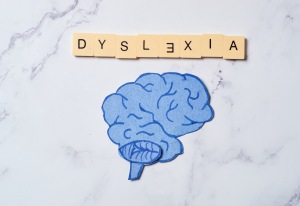Welcome to the Right Side – Dyslexia and Inclusivity
by Julia Beeby, Lead HR Consultant
How many Neurodivergents do you know or have in your team?
Have you ever even thought about it or even familiar with the term?
The term Neurodiversity refers to a variation of cognitive functioning in people. This cognitive functioning is not considered “typical” and encompasses a number of neurological conditions such as; Dyscalculia, Autisum, Dyspraxia, ADHD, Tourette’s syndrome, OCD, Social Anxiety, and Synesthesia just to name a few.
These exceptional individuals make up 1 in 5 [1] of the population so chances are you know one but may be unaware.
I’m a proud Neurodivergent with my difference in the human genome is Dyslexia.
So what is Dyslexia and why am I so proud to have this hidden talent?
Dyslexia is where the right side of the brain is more dominant. Everyone is born a right-brain thinker, babies recognise people by smells, images, and touch. As we develop there is a point where our interpretation of the world shifts. A percentage of individuals stay on the right side track and the others go off down a more left side track. There is also lots of fluidity in this, with individuals having their individual mix of left and right interpretation percentage.

Dyslexia is also a spectrum that varies for each individual ranging from mild to severe. This means within our own community we need a variation of support and our talents can peak in different ways. Although it is a permanent condition that can’t be ‘cured’ with awareness and support it does not have to be self-limiting.
If you do know about Dyslexia you are likely to link it with difficulties in reading in writing. Well, that’s actually just one of the six main types of Dyslexia [2]. I was diagnosed with Dyslexia at the age of 15 back in 1997, following a serious illness and some brain surgery. Therefore, it could be argued that my Dyslexia falls under the “Acquired” category. However, as my awareness has increased I look at family members and I can defiantly see the signs and traits so maybe I’m actually a primary type. Either way, my special talent has been something I’ve been fortunate to know about from a young age.
The Dyslexic Spikey Profile
I’ve found the best way to describe my Neurodivergent is the Spikey Profile image, this is probably also due to the very nature that many Dyslexics are visual learners.
Yes, I have troublesome areas such as reading speed, spelling and information processing, and recalling and translating my ideas in my mind to physical words.
However, I excel in creativity and imagination, problem-solving, building rapport with my conversationalist skills, and I have empathy in abundance. I’m also able to able to grasp the abstract such as interior design and layouts. This particularly comes in useful when undertaking our renovation projects! Even though I’ve had to learn how to spot the little details I’m much better at viewing things with a bigger picture lens. This often enables me to link patterns and connect things that others may have missed.

With the Spikey profile, I’ve worked on the areas that are troublesome and have developed and evolved coping strategies to get these as close to a “typical” range as possible. Developing self-awareness has helped me to understand what works best and I’m proud of what I’ve achieved.
Writing this blog has given me the opportunity to reflect on the fantastic champions in my corner. In particular, my teachers at high school who helped set me on a path of having the right support and self-development. Back then the Disability Discrimination Act 1995 had just been introduced, and this has evolved into the Equality Act 2010. Awareness was growing of hidden disabilities and learning needs.
As time has moved on I’ve witnessed an evolved understanding and acceptance alongside the massive technological advances that today make the world much more accessible and manageable for individuals like myself. However, there is still significant work to be done with the benefits of the Neurodiverse employee often overlooked.
My personal experience has on the whole been positive throughout both my education and career. I believe this is because I have been able to access assessments and reasonable adjustment support. I’ve also been fortunate in stumbling upon a career path I love and excel in as an HR professional. Ironically I actually hated the HR module I did as part of my degree! Reflecting back, this is because of how it was delivered and so I had limited engagement and interest in the subject.
Reasonable Adjustments
During my career as an HR professional, when I use the term Reasonable Adjustments, I’ve often seen a response of complete bewilderment or sheer panic from managers. As such, breaking down the jargon is of key importance. Reasonable adjustments help you overcome the challenges faced, just like lowering a curb for an individual who is a wheelchair user. Put simply making a reasonable adjustment enables you to get on with life.
Although I have been successful throughout my education and career, this is not the case for a significant number of Dyslexic individuals. A recent study published in 2020 by Badenoch and Clark, has shown that Dyslexic individuals are five times more likely to be unemployed. Dyslexic thinkers make up four in ten of the unemployed population which worryingly equates to around 7.3 million people in the UK.
From my HR experience, there certainly hasn’t been the same spotlight put on neurodiversity when compared with other protected characteristics. However, recognition and awareness are slowly occurring and the benefits of a neurodiverse workforce are evident. As stated by the CIPD “the most successful teams will have diverse perspectives and backgrounds and a good manager will know how to conduct these individual players to create an orchestra.’ [3]
One of the things I’m passionate about through working in HR is the fact I can be instrumental in raising awareness and help implement change. I mentioned above one of my Dyslexic talents is having empathy in abundance and am able to combine this with my rapport-building in my conversational skills.
Delivering compassionate HR is our driving philosophy at Grounded Human Resources and this is exactly what the neurodiverse community needs. So I gently challenge you – how have you accounted for neurodiversity in your company’s inclusion and equality strategy and outlook?
There are many resources available to help both employers and employees and, even if you know you have Dyslexia, learning more about your condition can unlock an understanding of yourself and what talent you have – it's not just that quirky thing you have always done!

Both The British Dyslexia Association (BDA) and The Dyslexia Association are great resources, offering a helpline and a route into a formal assessment. Alongside providing training workshops, they have created some fantastic guides and videos such as this 3 Strengths Dyslexia video. They also have free downloadable checklists/screeners, which can offer the first stepping stone to providing support.
We also have some great top tips for you at Grounded HR:
1. Take yourself back to the start of your customer/employee journey and consider the first interactions they have with your company. Have you considered if your website is accessible? This can be something such as the layout, text, and language used through to having timers counting down applying pressure to the user, and the ‘double speak’ in those pesky marketing tick box options.
2. What does your recruitment process look like? From your application forms through the use of psychometric testing. Are these inclusive and really attracting the best candidates? If you are doing psychometric testing don’t have a rigid reliance on these. Dyslexic individuals need extra time in examinations and tests and when exposed to stress and anxiety lose their focus. Think differently, like us, and consider getting a sample of their work from them and have them talk it through. Giving them ownership of how to put forward their best self will be quite a refreshing approach.
Employers often forget that recruitment is a two-way process, you are also being accessed by the candidate to see if you are an employer they wish to work for and if you are really as inclusive as you claim to be. Believe me, I’ve come across a number of negative situations where actions speak far more than the written policy.
3. Following on from actions being more poignant, be proactive and if you sense an issue with a member of staff don’t assume the worst. The power of a compassionate and honest conversation can work wonders. If you discover something you’re unsure about you can always contact Grounded HR for some advice too!
4. The Covid-19 pandemic has seen working from home become the ‘norm’ now giving rise to the hybrid role. This has had its pros and cons for a dyslexic individual. The way they interact and absorb new information has taken on a new dynamic. Simply asking for help has become more noticeable compared to a little chat with their colleague at their desk or over making a brew. Give consideration to how information is provided and their format – remember visual learning is important.
Video recording and screen sharing can really help dyslexic’s understand and retain information compared with a telephone call or email. There are numerous video software solutions available such as Loom or Vidyard alongside tools such as Zoom and Microsoft Teams.
A simple reasonable adjustment may be providing printing facilities as many dyslexics print documents and emails to mark up so they can pinpoint the important points.
5. As we do see a move back into the office re-evaluate your space. Designing spaces for purpose can make a significant impact and enables employees to choose what best suits them. For example; large breakout rooms for socialising, quiet areas for reflection, enclosed spaces for focus, dedicated meetings and phone calls.
6. The pandemic has also given the rise to dividers and screens. This can actually be useful as they block out noise and distraction. Couple this with adding hot desking in a low traffic area can help employees to work flexibly in a calmer environment.
On a final note I love this quote:
“I didn’t succeed despite my dyslexia, but because of it. It wasn’t my defict, but my advantage. Although there are neurological trade-offs that require that I work creatively [and] smarter in reading, writing and speaking. I would never wish to be any other way then my awesome self. I love being me, regardless of the early challenges I had faced.”
- Scott Sonnon, Martial Arts World Champion & Author
To find out more about how we can help you visit our services page: Grounded HR Services or send us an email at hello@groundedhr.co.uk
[1] 7 Hidden Traits of Dyslexia – The Right Siders
[2] https://www.readandspell.com/different-types-of-dyslexia
[3] Neurodiversity at Work Guide, CIPD, 2018

